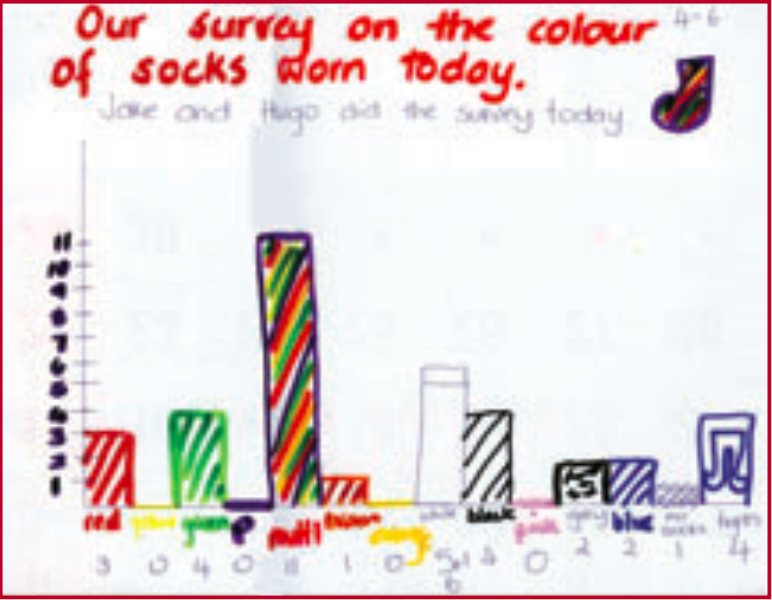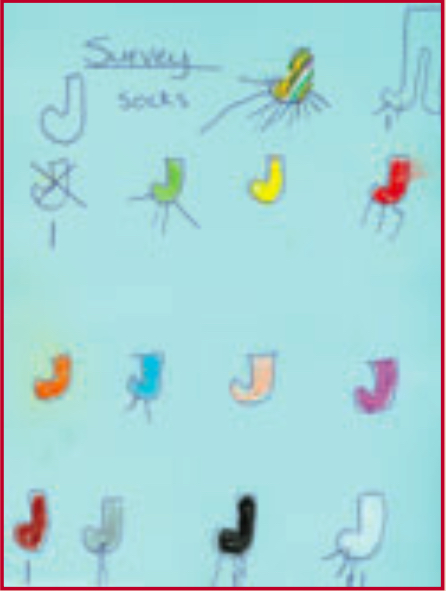Kei Tua o te Pae
Kei Tua o te Pae/Assessment for Learning: Early Childhood Exemplars is a best-practice guide that will help teachers continue to improve the quality of their teaching.
The exemplars are a series of books that will help teachers to understand and strengthen children's learning. It also shows how children, parents and whānau can contribute to this assessment and ongoing learning.
We are making improvements to our download-to-print functionality. So if you want a printed copy there are PDF versions available at the bottom of the main cover page.
Exemplars – Ngā tauaromahi
-
Quin and quarters
-
Child: Quin
Teacher: Carlotta
Quin was really interested in using the ruler and pens. She got a little frustrated with using the felt tip along the edge of the ruler and chose to paint on the paper I had just ruled into quarters. She followed the ruled lines with a crayon before painting each individual quarter. This resulted in a symmetrical look which she appeared to be really happy with. “I’ve got four rectangles – they’re quarters, aren’t they, Carlotta?”
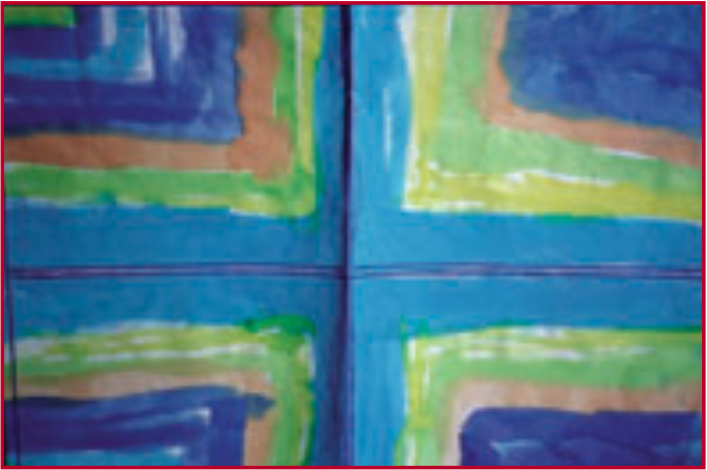
-
-
Hamish sews a corgi
-
Child: Hamish
Teacher: Julie
Date: 18 September
The corgi sewing project started today! After we had pinned the pattern (Hamish’s fantastic drawing) to the fabric and cut it out Hamish said, “I can sew by myself – I don’t even need any help!”
“Great, Hamish – there you go – you know what to do!!”Hamish did just that – total concentration – fully bent to the task. “I’ve done five stitches,” and he had – very neat and right where they should be – I was impressed. I stayed sitting by him talking with the other children and watching his progress. He did a lot more before he looked up and needed a break. “Look how many I have done now – I’ve just about used up all the wool!”
“Wow – so you have!” I said. “How many stitches do you think you’ve got now?”
“Maybe more than twenty,” Hamish said.
“Great, let’s count!” I replied.
We counted together – exactly twenty stitches. I rethreaded the needle and away the corgi maker went again – this time with me holding the fabric while Hamish did the sewing. After a little while Hamish said, “Look how much wool there is left,” and he used the length of wool and needle to measure it against the end of the table, then the easel. I asked him to predict whether it would be longer or shorter than a few other things around us before he went back to his sewing – and he was often right in his estimations.
“This is the second corgi you have sewn, isn’t it, Hamish?” I said. “Yes,” he said. “But I can’t find the other one – it’s lost.”
“Oh,” I said.
“But that’s OK,” he said, “that happens,” nodding his head with an accepting, wise look on his face.
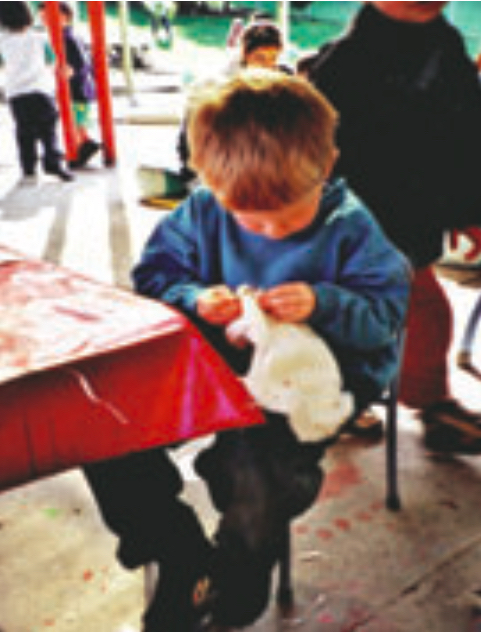
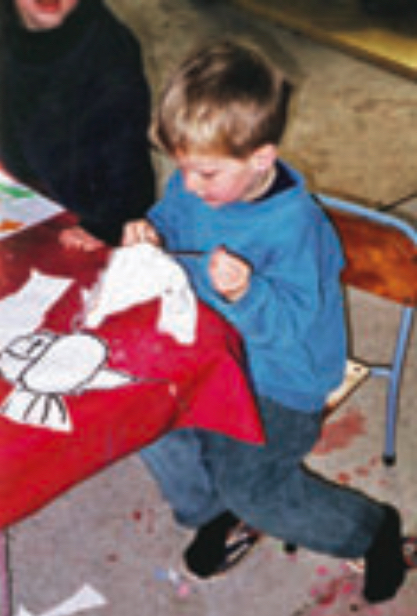
Short-term review
This is only the second sewing project Hamish has done at kindergarten, so I was really impressed with his ability to sew so confidently and also so well!
His passion for and delight in his ability is wonderful – what a fantastic learning disposition – a real interest in and confidence to tackle a tricky task – and stick with it (persevering with difficulty).
Hamish was also exploring some mathematical concepts when making his corgi today.
And last but not least – Hamish has grasped the concept of impermanence: “But that’s OK,” he said, “that happens,” nodding his head with an accepting, wise look on his face.
OH WOW!!!!!!!!
Question: What learning did I think went on here (that is, what are the main point[s] of the learning story)?
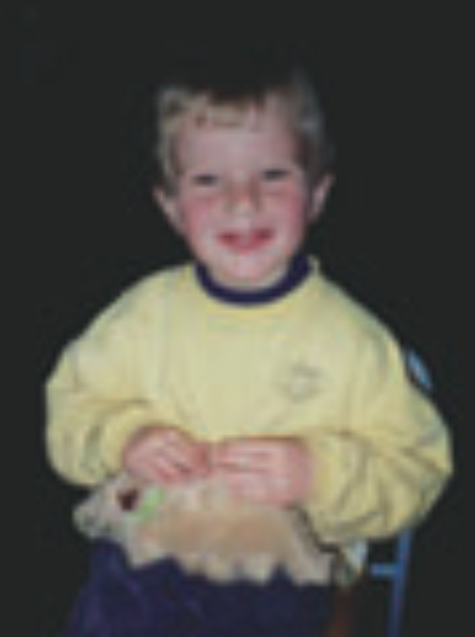
What next?
Finish the corgi.
Last kindergarten day for Hamish this Friday, then off to school – we will be very sad to see him go.
-
-
Ordering by size
-
Child: Nicholas
Observer: Julie
Date: 14 March
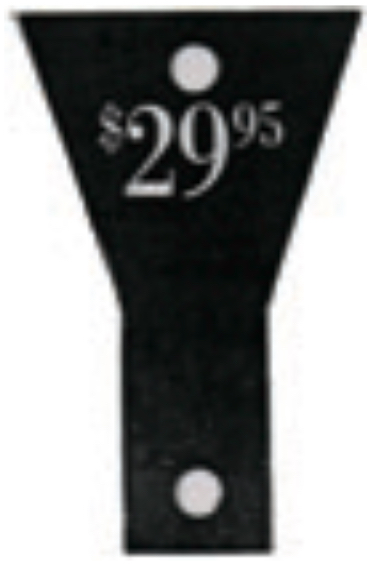
$29.95
Nick asked me how much this was.
“Twenty-nine dollars, ninety-five cents, Nick,” I said.
“That’s a lot of money – but I’ve got heaps of money. When my Nana died, she left me some money,” Nick told me.
“What will you spend it on, Nick?” I asked. “A motorbike!” he told me.
“How about drawing me a picture so I can see what sort of bike you’ll buy?” Nick drew several bikes and ordered them from small to large.
“The big one is a Harley-Davidson!” he said. “The Harley has stripes. I think the wee seatbelt is at the back for the wee person. I don’t know why they have two aerials at the back!”
“Yeah, I don’t know. Why would they have aerials?” I said.
Nick said, “The aerials are for the wee microphones in the helmets – so they can talk to each other – so the driver can hear the person at the back. Harleys can go really fast – about forty speed or ninety speed or something. The wee ones is ... One is a Honda, and there’s a Ford and a Mercedes.”
“Wow, Nick! You know a lot about bikes. Would you like to tell me more or is that the end of the story?”
“It’s the end,” said Nick.
Short-term review
I had such a lovely talk with Nick today – firstly about money and motorbikes and then later about some pictures he was interested in.
Nick shows he is aware that the symbols indicate an amount of money on the price label but he didn’t know how much. He feels confident to ask for help when he needs it and he really seems to enjoy having a good in-depth talk from time to time. We probably spent at least half an hour chatting together today. When I see an opportunity to invite Nick to draw, I take it – and he is becoming more confident and willing to take risks with writing and drawing. I love the way Nick’s first bike was very small, then he branched out and drew bigger and bigger bikes, culminating in the Harley. The ideas and inventiveness in his thinking about aerials was great I thought. “Wee microphones” in the riders’ helmets so they can talk to each other!!! And obviously he has an understanding that aerials are needed for the transmission of sound.
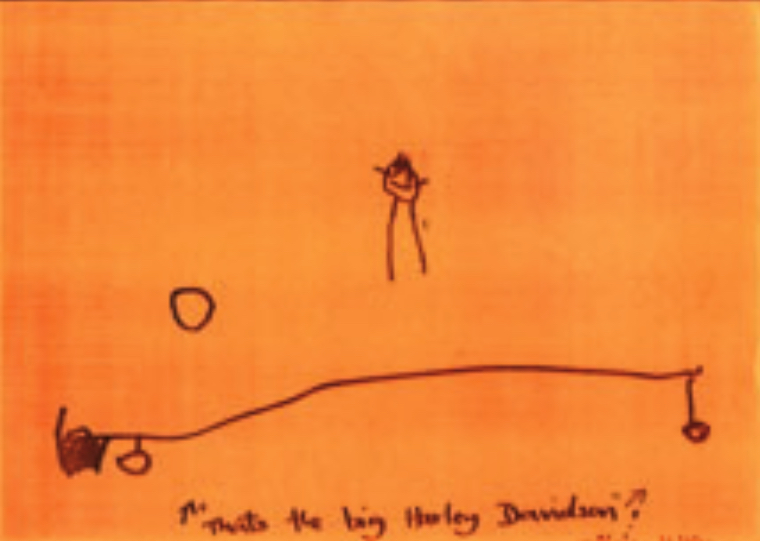
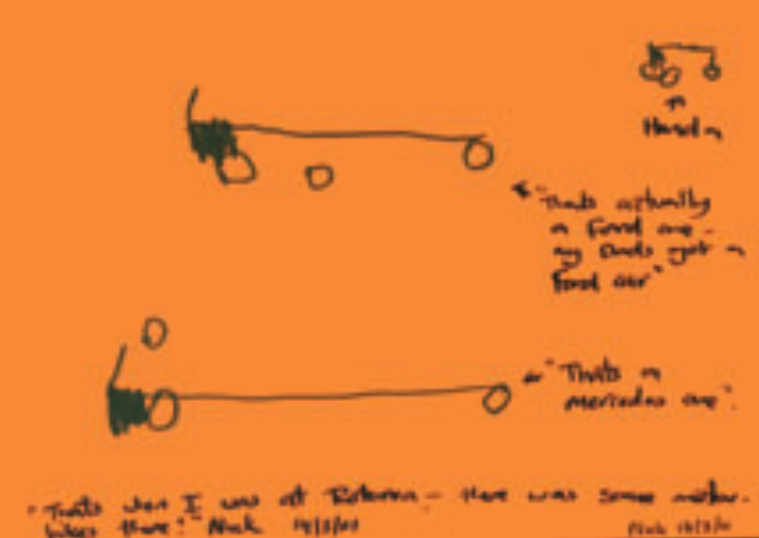
-
-
Preparing a budget and playing with numbers
-
Child: Lute
Teacher: Karen
Date: 20 March
Examples or cues A Learning Story
Belonging
Mana whenuaTaking an Interest Finding an interest here – a topic, an activity, a role. Recognising the familiar, enjoying the unfamiliar. Coping with change. This morning a group of children and I were looking through catalogues. The children were selecting equipment that they would like for their outdoor area. (We were applying for a grant.) They had great delight picking and choosing, and recorded their choices by drawing pictures to send with our grant application. I went to get a calculator to add up the cost of the children’s choices. When I returned Lute had been busy writing letters on the blackboard.
“I did my sister, my nana, my dad, my mum, my name, ‘Lute’, and my grandma,” she told me as she pointed to the words she had written. I continued working with the group of children. We added up the cost of the equipment. I got called away to take a phone call and when I returned I couldn’t find the calculator anywhere. I searched under all the papers under the catalogues and asked the children to help me look. We hunted everywhere. “Where could that calculator be?” I asked the children.
Then I looked over to Lute. She was taking no notice of the other children and me. It was as if she was oblivious to her surroundings. She was very busy. She was pressing keys and watching the numbers come up on the screen of the calculator, reading them aloud, and then recording them onto her blackboard. Lute wrote the numbers in the same form they appeared on the calculator screen. When she had finished writing them on the blackboard she took my pen and copied onto paper what she had written on the blackboard. Lute was very proud of her writing and spent a long time writing numbers.
Well-being
Mana atuaBeing Involved Paying attention for a sustained period, feeling safe, trusting others. Being playful with others and/or materials. Exploration
Mana aotūroaPersisting with Difficulty Setting and choosing difficult tasks. Using a range of strategies to solve problems when ‘stuck’ (be specific). Communication
Mana reoExpressing an Idea or a Feeling In a range of ways (specify). For example: oral language, gesture, music, art, writing, using numbers and patterns, telling stories. Contribution
Mana tangataTaking Responsibility Responding to others, to stories, and imagined events, ensuring that things are fair, self-evaluating, helping others, contributing to programme. 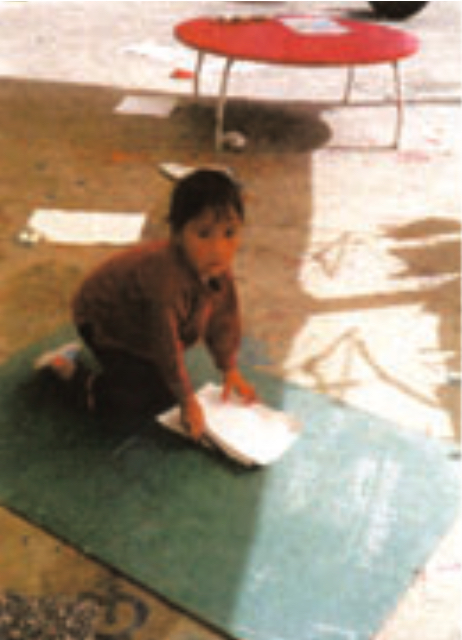
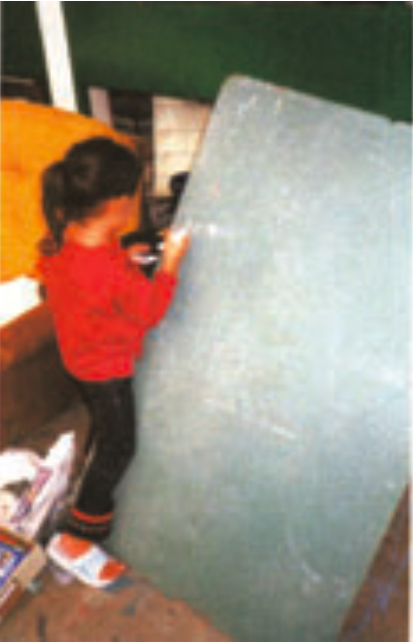
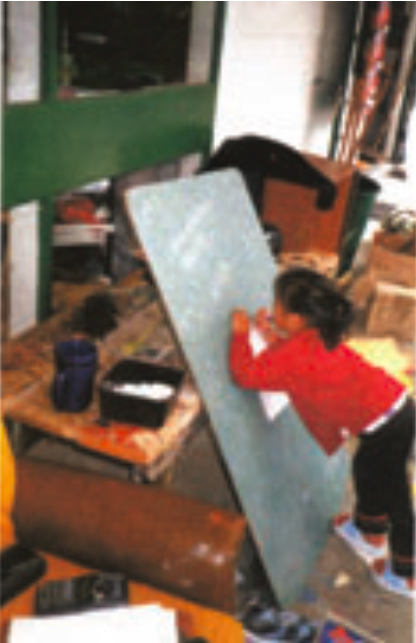
Short-term review
Lute has a passion for writing: she is experimenting with numbers and letters. Lute has an understanding that numbers and words can be recorded and read.
What next?
Encourage Lute’s literacy and numeracy skills through different media – the blackboard, whiteboard, magnetic letters and numbers, counting in dance and movement games.
-
-
Measuring the play dough
-
Child: Tom
Teacher: Rosie
Date: February
A learning story
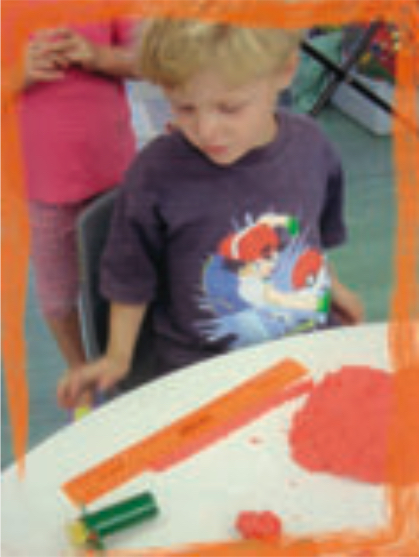
Tom held up a long piece of play dough he had squeezed from the piping equipment and exclaimed, “Look, Rosie – it’s sooo long!”
“Yes, you’re right, Tom, it sure is! Let’s get a ruler and measure it to see how long it really is,” I suggested.
Tom placed his play dough strip along the tape measure.
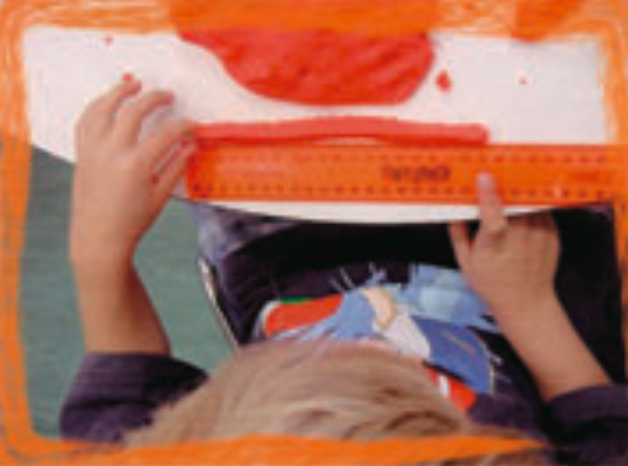
It’s 19 long!!
Can you see the numbers, Tom? They tell you how long it is,” I explain.
After studying the numbers carefully, Tom cleverly announced, “19 long.”
“Yes, 19 centimetres,” I add.
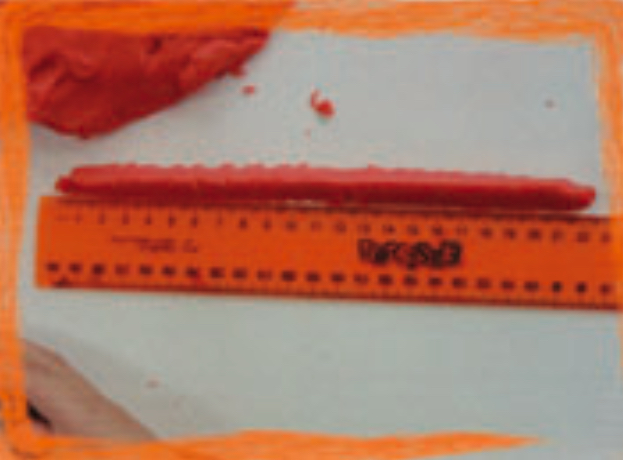
This one is 22 centimetres.
“I’ll make another one – but even longer this time. Look, this one is ... 22 centimetres,” he continues.
“Wow, can you make the strip as long as the ruler – 30 centimetres long, Tom?”
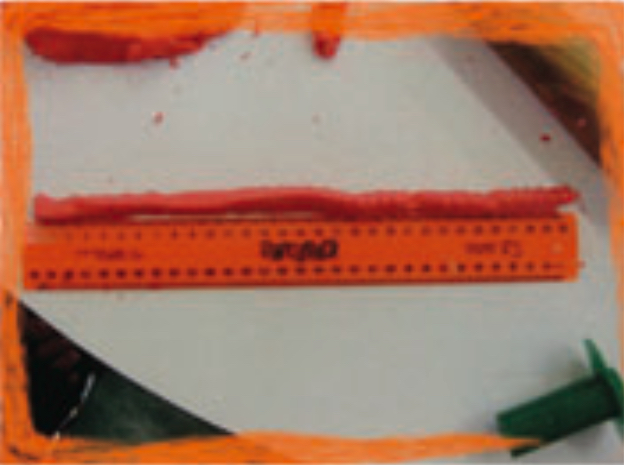
I’ve made it 30 centimetres now!!
After much squeezing and slight adaptation, Tom successfully makes the strip reach from one end of the ruler to the other.
“Look – it’s 30 centimetres long now!” he announces proudly.
Short-term review
Tom is always so interested and captivated by whatever is happening at kindergarten. His number recognition is superb. He easily tells me the numbers on the ruler as he reads them. Measurement is a constituent of the maths curriculum at school – clearly Tom has already mastered a fundamental use of the ruler. He made sure the edge of the dough strip corresponded with the beginning of the ruler so that the dough length could be measured accurately.
Well done, Tom. We’ll have to measure you to see how tall you are now. That would be a great big number!!

-
-
Ezra explores height, balance, measurement, and number
-
28 February
Ezra wanted to be really tall today. He was walking around with the sawhorse held up high over his head. Later I noticed him under the tree house positioning the sawhorse in different ways, trying to reach the bottom ledge.
He tried standing on both the bottom and top of the sawhorse.
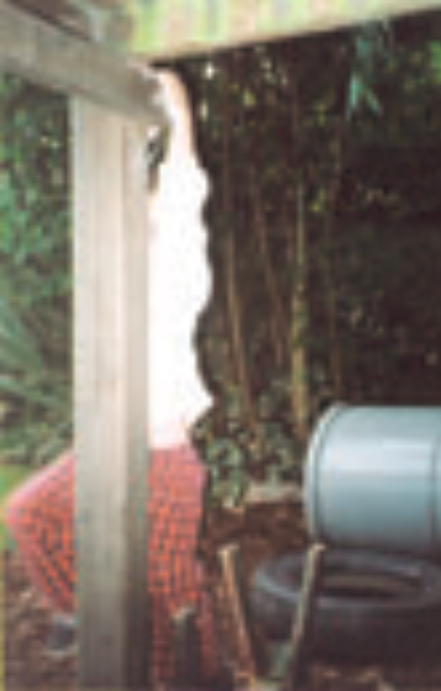
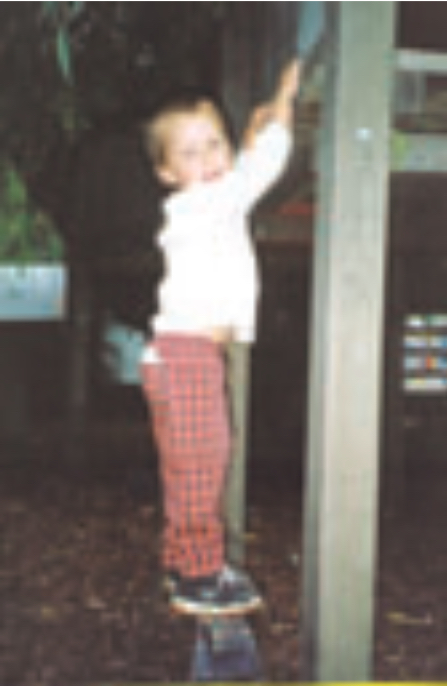
The sawhorse is upside down with its legs standing up. Ezra works out how to reach the ledge more easily. Then with intense concentration he walked around the playground. “I’m going to reach that tree.” But he placed the sawhorse on the concrete path.
I asked, “What would happen if you fell off?” He looked around without answering and moved onto the grass until he decided on a spot. He reached up and could just reach the leaves. Then he said, “You get some string and measure me.” I found some lovely red ribbon and together we spent some time measuring and cutting lengths while he stood either on the grass or on the sawhorse.
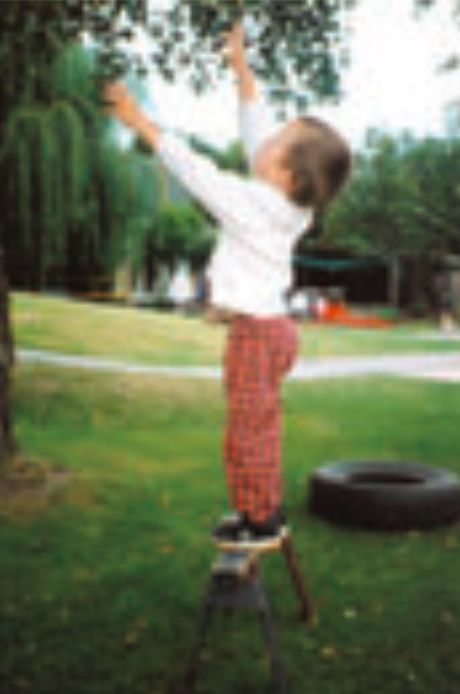
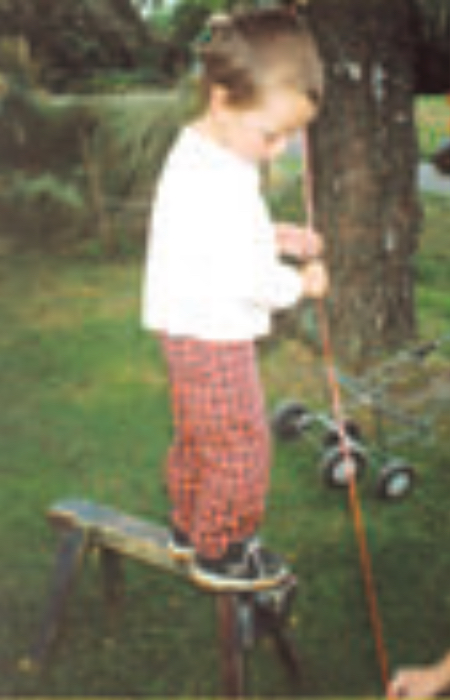
An audience came to watch while we compared lengths.
Ezra decided he wanted the string tied to the branch so he could “swing”.
“You pull out the little stool so I can swing,” he insisted.
We did a countdown. “3 ... 2 ... 1 ...Go!!” And he jumped.
“Who wants to jump with me?” he asked the audience.Several children wanted to join in and Ezra said, “This is going to be fun, eh?” The children agreed.
I left them to “swing” and they spent some time negotiating the process and how to hold the ribbon.
Short-term review
Ezra showed amazing problem-solving skills and a real interest in measuring. This solitary activity ended up being quite a social experience. Ezra is developing ways to include others in his play. Ezra needs more opportunities to expand his interest in measuring and maths concepts that also include his peers.
Voice from home
When this story was shared with Ezra’s mum and her partner, Ezra’s mum said that she had measured him against the wall a very long time ago. She didn’t use string! Gareth (her partner) commented that they often tell Ezra if he eats up all his food he will grow big and strong. Ezra also gets up on a chair to see if he is as tall as Gareth.
Child’s voice
When Sandra shares the story and photos with Ezra, Ezra responds, “I am trying to reach that branch, eh?”
“I’m measuring myself with a piece of string.”
“I was holding the piece of string and I was SLIDING down, eh?”
“Hey, that’s me,” he said pointing at his name. “There’s me, ‘E’ ‘Z’ ‘R’ ‘A’,” he said, pointing to each letter.
11 March – several days later
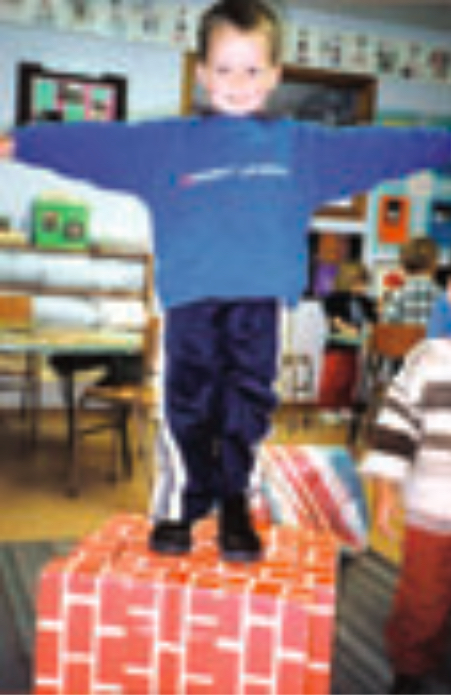
“I’m balancing!”
Ezra wanted to balance on the building bricks. He tried standing on just three but they kept falling. He then spent some time standing up all the bricks in a group. Finally he stood on them, arms outstretched and said, “I’m balancing.”
Sandra: “Wow, look at you! How many bricks did you have before when you kept falling down?”
Ezra thought for a while and held up four fingers.
Sandra: “Was that enough to balance on?”
Ezra shook his head.
Sandra: “So how many bricks did you need to balance?”
Ezra got down and counted, touching each brick as he said a number.
Short-term review
Ezra problem-solved this task all on his own. He realised more bricks were needed to support his weight and the outcome was successful.
16 March
Several days later when playing outside, Ezra found a long tube. He ran over to me and asked, “Am I taller than this?”
“How might you work that out, Ezra?” I questioned.
Ezra stopped for a moment. He stood up straight against the wall and held the tube against himself. “You can look and tell me,” he said.
“Good idea,” I said. “No, it is just slightly taller than you.”
“Hmm,” said Ezra, “what about Eisak? Is she taller?”
Ezra held the tube against Eisak as he had done against himself and he compared.
“Yes, Eisak is taller!” he declared.
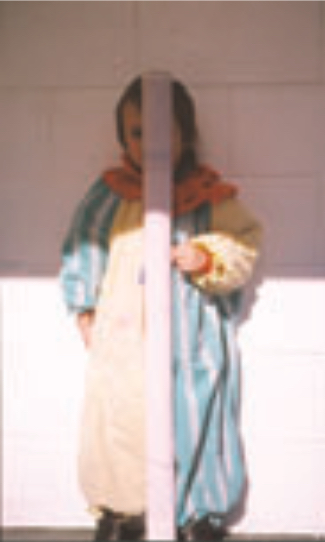
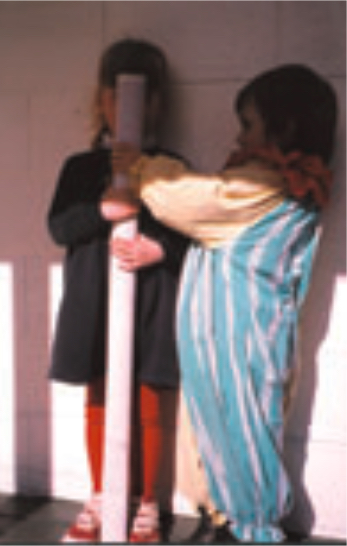
-
-
Jack explores space
-
Child: Jack
Teacher: Sue
18 March
Jack was sitting in the block corner stacking Duplo blocks on top of one another. He then reached for the train and tried to stand a piece of Duplo on top of its funnel. This did not work so he went back to stacking the Duplo.
Jack noticed another child approaching but carried on stacking. The child watched him and then helped him stack by handing him a block. Jack took it and stacked it. He then tried to stack the Duplo upside down but found this didn’t work, so he went back to stacking them the right way up.
The child helping Jack brought hand puppets but Jack wasn’t interested in the puppets. Jack then sat the Duplo on the sill of the floor-to-ceiling window, stacked them, then left to play elsewhere.
Interpretation/Analysis
The amount of time Jack spent at this activity stood out for me, eight minutes in all. The fact that Jack did notice the other child, but did not really interact with her even when she brought the hand puppets over, showed that he was really involved in the task at hand.
What next?
Provide Jack with a variety of resources that can be stacked or used to build things (different sizes and shapes of blocks, large cardboard bricks).
19 March
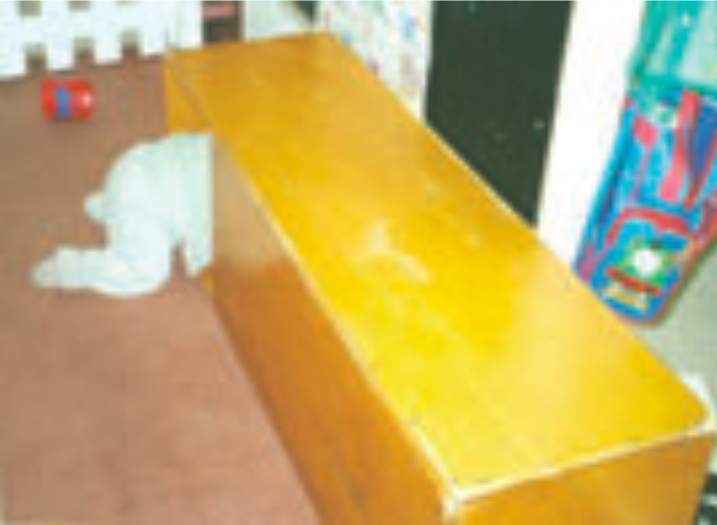
While all the toddlers were asleep Jack explored the toddler area.
The large wooden tunnel took his fancy. He put his head inside it, laughing. He was laughing louder when he took it out again.
Jack played peek-a-boo with a staff member. On the completion of this game Jack went through the tunnel.
Teacher: Cilla 4 October
Jack loves balls. Today he found a ball outside, put it in a trolley and pushed it around the playground. He made a growling noise at his trolley if it did not go the way he wanted it to go. Jack spent 5 minutes taking the ball for a ride, then he picked up the ball, took it up the fort, and rolled it down the slide. I helped Jack come down the slide. He giggled, retrieved the ball, and repeated his slide game several times.
Interpretation/Analysis
Jack initiates his own games with items that interest him. He is playful with equipment and expresses his feelings verbally and through gestures.
15 October Jack tackles the steps
Today under the watchful eye of one of his larger mates, Jack tackled the wooden stairs. His socks were proving to be a little problem as he kept standing on them, so off they came.
Claire stayed behind Jack as he made his way to the top of the steps, calling out “Jack, Jack” once he got to the top.
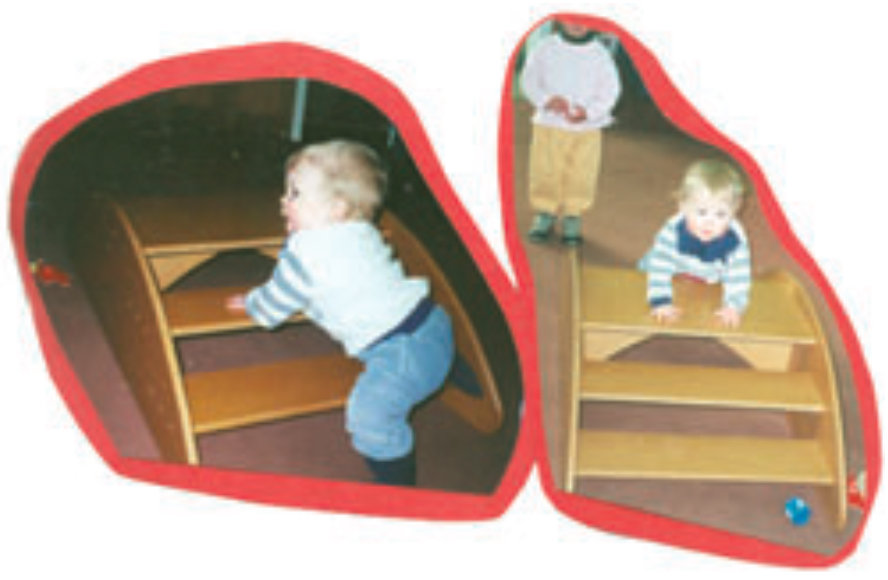
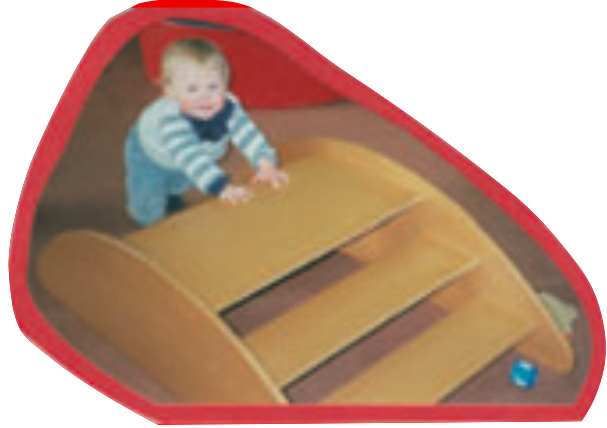
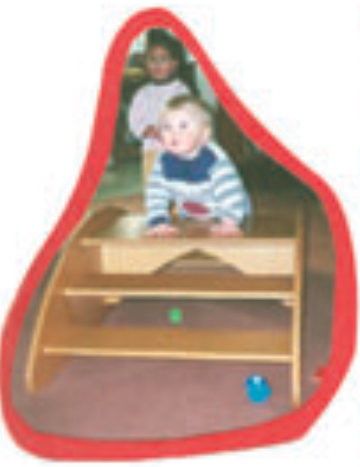
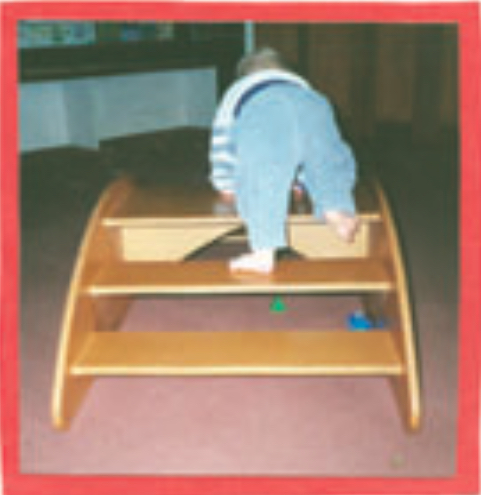
Teacher: Sandi 23 October
Today I was delighted to see Jack and Georgia initiating play with each other. Georgia first got Jack’s attention by squealing at him as he walked past. She then crawled to the end of the wooden box. Jack then came over and peeped right back. They took turns looking and laughing at each other. Jack then crawled through the box and Georgia followed. They did this several times, laughing and “talking” as they played.
Interpretation/Analysis
Jack and Georgia were able to play together.
They took turns responding to each other’s ideas and were involved together for some time.
What next?
Keep noticing the friendships made in the nursery.
Teacher: Sandi 4 November
Jack has shown an interest in posting objects. Today he was putting shapes in and out of containers and then hiding them under the cushions. Jack showed delight when the objects/shapes were tipped out of the container. He smiled and repeated the task.
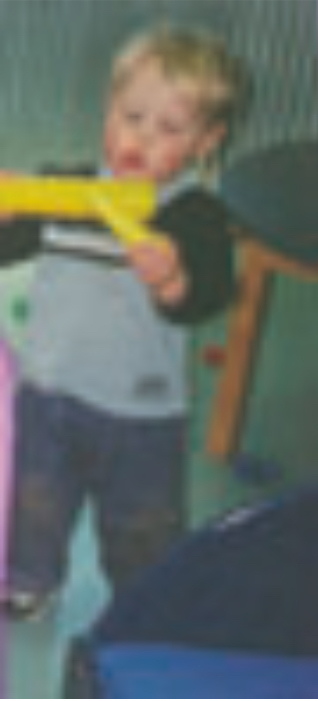
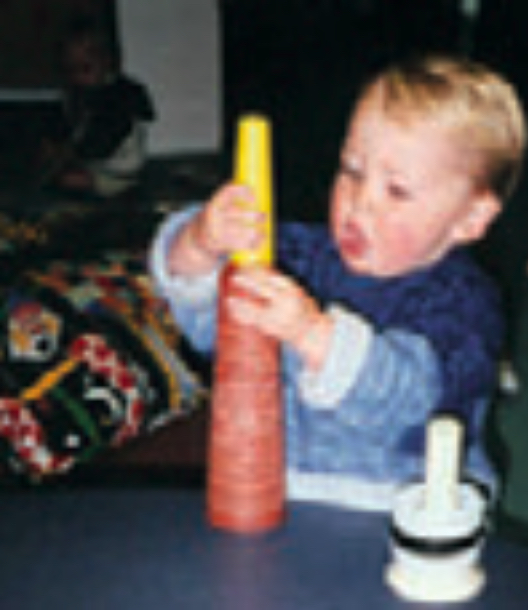
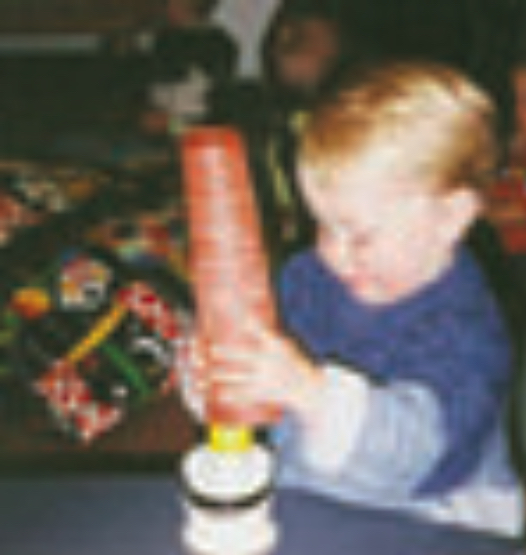
Interpretation/Analysis
Jack chooses play of interest to him. He plays around with equipment and gains much satisfaction from this type of exploratory play.
What next?
Increase the range of posting and heuristic play time and equipment to support Jack’s interests.
5 December
As a toddler Jack’s interest in stacking and manipulating objects continues. On many occasions Jack has been observed stacking a selection of cones one on top of another.
Teacher: Cilla 12 December
Jack loves hiding in boxes. Today he emptied out the sand toy-box to as far as his arms could reach, then climbed inside the box. He smiled at his teachers, then spent a few minutes searching through the toys, every now and then throwing something out until he found a sponge piece. He got out and returned this to the water play. Later on he was seen hiding in the toy oven and playing “peek-a-boo” with another child, using the playhouse window as a screen.
Short-term review
Jack enjoys discovering hiding holes. He will spend time each day in a private space – corner, box, tunnel, basket – by himself or with one other child.
-
-
Jake's survey
-
Child: Jake
Teacher: Shelley
Date: 6 June
Jake arrived, walking up the ramp, saying he would like to do a survey on bags. He came to me and we talked about how he would need to go about this. Jake thought this topic was a good idea for a survey as he didn’t have to ask anyone any questions!!
Jake had a clipboard and worked on the yellow table. He drew bags and coloured them. “Look, this one doesn’t have a handle,” he said.
I asked if he was going to include multicoloured bags. Jake explained that there were no multicoloured crayons. I suggested he go and have a look at the sock graph to see how I had depicted multicolour socks. He came back still stumped. Finally I asked if he needed help. I showed him how I drew lines of different colours. At the table the other children discussed what made “multicoloured”. Two colours were two-tone, so you needed three or more to be multicoloured. Jake also drew a big bag with a cross through it to signify “no bags”.
He worked through looking at the lockers. Then he came to get me. He was not sure if he had got them all and said there were a lot with no bags. I asked if he had started from the top and worked along.
Jake looked horrified. “I started from the bottom and worked along.” I explained that that was fine, and that I was just checking that he had worked in a line to make it easier and it didn’t matter where he started. Jake was fascinated that there were some bags the same as each other.
Short-term review
This boy works to a plan. He is systematic and likes to complete a job. Jake has become very involved in surveys and likes to discriminate, sort, match, count and record. Jake is absorbed in thinking up ideas of what he would like to survey.
What next?
Jake seems totally in charge of this!
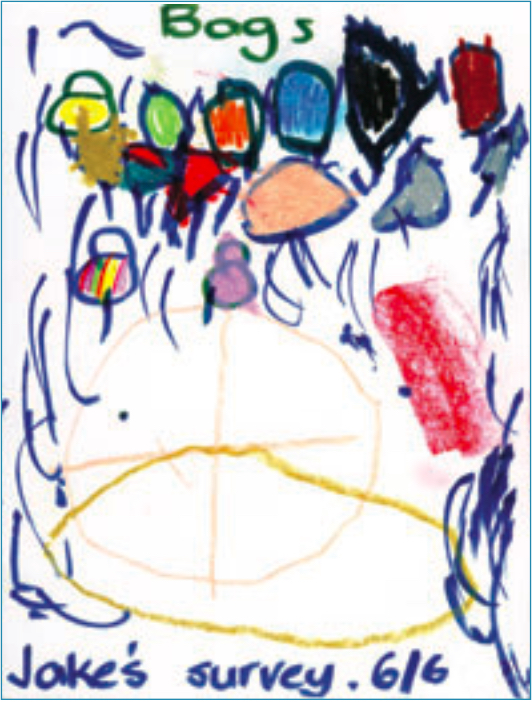
-
-
Collaborative building with unit blocks
-
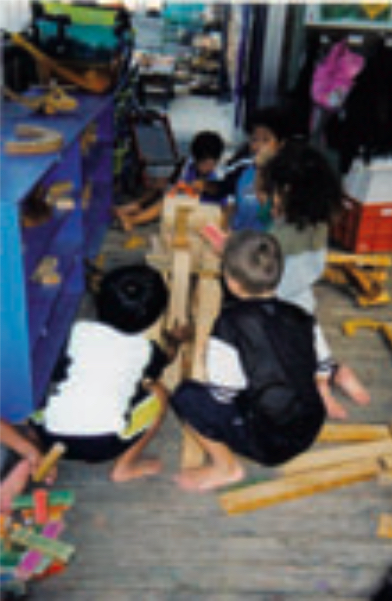
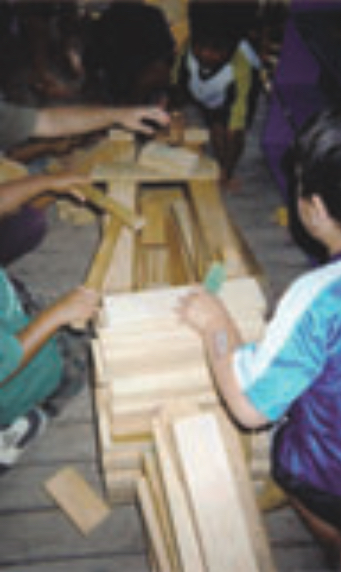
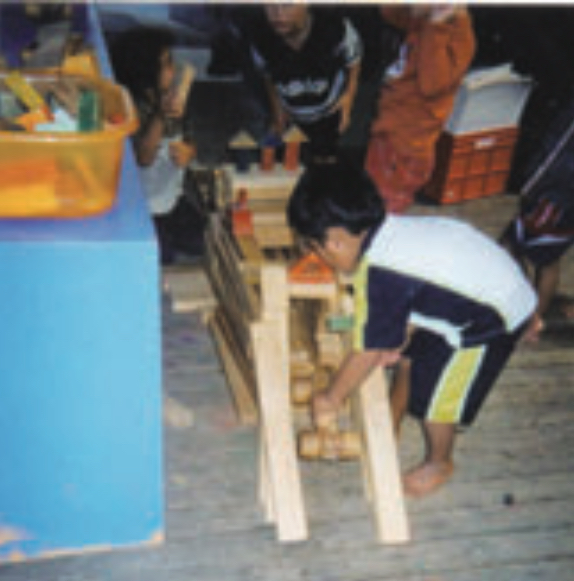
‘O le ‘āmataina lenā o le fauina o le fale ta‘avale. ‘Ua fāatutū i luga pou, ma tu‘u i ai laupapa e fola ai. ‘O lenā ‘ua o‘o i le fauina o le taualuga. Tu‘u i ai isi laupapa e ato ai. ‘Ua fa‘ai‘uina le gāluega, ‘ua tū mai le fale ta‘avale. ‘Ua fa‘asolo atu ta‘avale i totonu e fa‘amomoe.
‘O le faitoto‘a lenā e pito i luma e ō atu ai ta‘avale i totonu.
Name: Trujon
‘O le tulimanu o poloka sa tā‘a‘alo ai Trujon ma tamaiti mātutua. Sā filifili mai na‘o laupapa lāpopo‘a muamua ma fa‘apito i lalo e ‘āmata ai le gāluega.
‘O lona iloaina o lana gāluega ‘olo‘o fai na fiafia ai ma fa‘aaogā lona māfaufau e fa‘ailoa i ana gāoioiga.
Fai i tamaiti e tāofi, fa‘atū, va‘ai i pā‘u‘ū. ‘O le fale ta‘avale. Tu‘u i luga le taualuga.
Na pā‘u‘ū laupapa ma toe fausia i luga ma fesoasoani i ai isi tamaiti. Na mana‘o e fesoasoani tamaiti ‘iā te ia. E tasi le itulā ma le ‘afa na fai ai le gāluega ma māe‘a lelei le fauina o le fale ta‘avale.
Points of interest/learning take place
‘O le ‘umi e galue mālosi ai ona lima i le faiga o le gāluega. Tautala mai fa‘ailoa lana mea ‘olo‘o fai. Fa‘atonuga i tamaiti mana‘omia le fesoasoani – taliaina isi tamaiti.
Ideas to be developed
‘Ia toe fa‘alauteleina pea lona iloa o le fa‘aaogàina o peni, vase, pepa e tusitusi ai nūmera, ma mata‘itusi e ‘āmata ai ‘upu o ana gāluega fai.
How your child is progressing at the centre ...
E tele ni vaega fa‘alea‘oa‘oga ‘ua mafai ona a‘oa‘oina ai Trujon. ‘O se tama e mālosi lona tino ma mālòlòina. E fiafia o ia e tā‘a‘alo ma gālulue fa‘atasi ma isi tamaiti. Na te iloa mea ta‘alo e tatau ona fa‘aaogà i lea taimi ma lea taimi o le aso. ‘O Trujon ‘ua mālamalama lelei i tulāfono tatau, po‘o mea e lē tatau ona fai. E tautala i tamaiti ma ta‘u i ai le mea e fai. ‘O se tamaitiiti e fai ma ta‘ita‘i lelei, ma e ‘avea fo‘i o ia o se fa‘ata‘ita‘iga i isi tamaiti. Na te tōina pese e ‘āmata ai le ā‘oga po‘o pesepesega fo‘i. ‘O ona mālosi‘aga o ta‘aloga e pei o polo, fa‘akāmuta, oneone, vai ma gāluega e fa‘aaogà ai lona māfaufau.
Parent comments
‘O Trujon o se tamaitiiti e fiafia i le pese o pese Sāmoa ma pese lotu. ‘Àfai e fai atu se isi iā Trujon e pese, e lè mā Trujon, e pese leo tele. E matala lelei ‘upu, ma ‘a fa‘apea ‘ou te tau pese atu ‘ae ‘ese ‘upu ‘ou te pese ai, e fa‘atonu mai e Trujon le sesē. E fiafia Trujon e alu i le À‘oga Aso Sā. E iloa ma manatua e Trujon ana tauloto i tausaga ‘uma. ‘A fa‘apea ‘e te fesili i ai po ‘o le ā lau tauloto i le tausaga lea ‘ua te‘a, e fa‘alau mai e Trujon. ‘O le isi mea e fiafia ai Trujon, ‘o le ta‘alo ma polo ta‘alo, po‘o le polo lakapì, po‘o le polo soka, po‘o le tà polo, po‘o le voli polo, po‘o le polo tènisi, ‘aemaise le pasiketipolo “basketball”. E lelei lana togi, sapo ma le kiki. (E lelei le ta‘i ma le “hand- eye coordination”. ‘Ua ‘āmata ona fiafia Trujon i le valiina/tusiina o ata. E fiafia tele Trujon i mea fa‘akàmuta (fauina o roketi). E fiafia Trujon e fai e ia ana mea, po‘o le faiga o ona ‘ofu, po‘o lana mea‘ai. ‘Ua ‘āmata ona viga Trujon e fia alu i le ā‘oga a tamaiti ‘ua ‘àtoa le 5, ‘ae le‘i taitai – toe tasi le tausaga.
-
-
Playing with repeated patterns
-
Child: Jessica
Teacher: Anne
Date: 29 April – 16 May
Jessica began sketching with enthusiasm, and with great experimentation. She played with the koru pattern by connecting it in an interesting way. She even added spirals in the writing of her name.
Her sketching also includes pictures that have meaning for her, i.e., a person and a house. Her black and white painting is a reflection of her sketch, as is her final PVA picture.
A few days later her mother showed me a fascinating drawing that Jessica had worked on at home. I looked at the series of photograph frames. “Look, these make them stand up” (she pointed to the stands) “and this is one person,” said Jessica.
Short-term review
Jessica is observant and creative. She loves to draw and focuses on detail. I remember showing her how the koru patterns were repeated and we discussed this. One can only wonder if she is experimenting further with repeating a pattern in this very mathematical drawing.
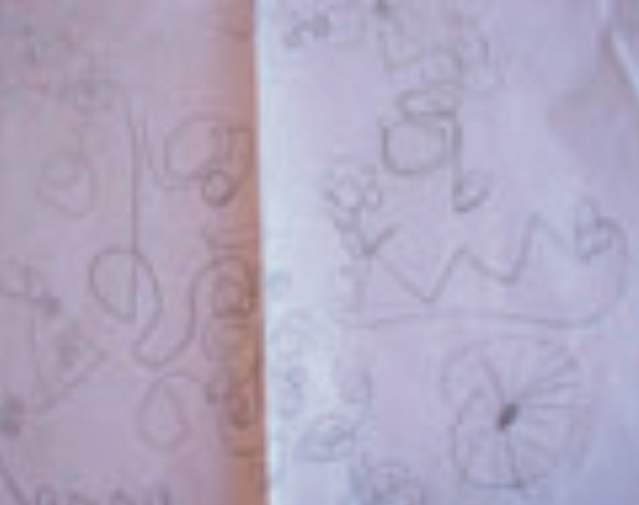
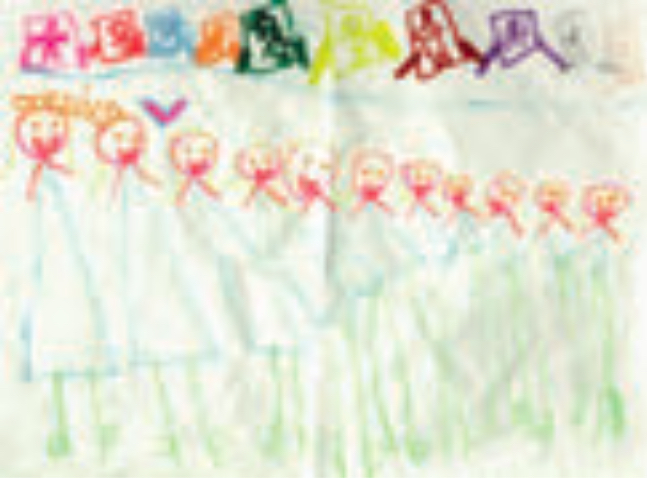
-

